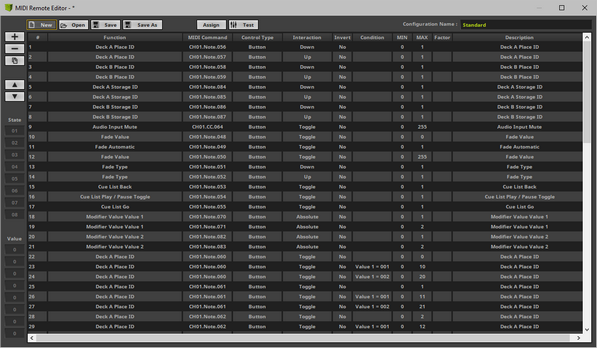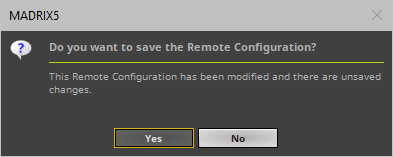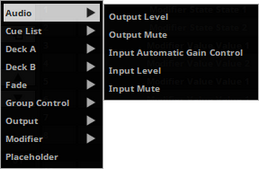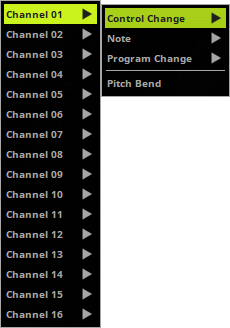This topic includes:
| ▪ | Introduction |
| ▪ | Initial Configuration |
| ▪ | Overview |
| ▪ | Keyboard Shortcuts |
MIDI controllers are often used to control MADRIX 5 remotely. While you can use preconfigured MIDI maps [i.e., a MIDI Remote Configuration], you can also set up such a configuration according to your needs with the help of the MIDI Remote Editor. This topic describes how to use the MIDI Remote Editor.
| ▪ | Make sure to configure your MIDI device first. |
| ▪ | Set up MIDI Remote Control. |
| ▪ | Learn more »MIDI-IN Configuration |
| ▪ | Go to the menu Preferences > Remote Control > MIDI... or to Preferences > Device Manager... > MIDI [Keyboard shortcut: F4 > MIDI ] |
| ▪ |
| ▪ | A new window will open. |
| ▪ | If you are creating a new MIDI map, the list will be empty. |
| ▪ | If you are modifying an existing MIDI map, the list will already contain all preconfigured settings. |

|
Add - Adds a new item to the list. |
|
Duplicate/Copy - Copies and duplicates the currently selected list item. The new item will be added to the list right after the selected item. You can change its settings afterwards. |
|
Navigation - Allows you to select the next or previous list item. |
|
New - Creates a new MIDI Remote Configuration while deleting all previous list items with your permission. |
|
Open - Loads a MIDI Remote Configuration into the MIDI Remote Editor from an external file [of the file type *.mmrx]. |
|
Save - Saves the current MIDI Remote Configuration to an external file [of the file type *.mmrx]. |
|
Assign - Allows you to assign a control of your MIDI console to a function in MADRIX 5. |
|
Test - Allows you to test single list items and their functionality on the MADRIX 5 user interface, while having the MIDI Remote Editor still opened. - Test is also useful for testing modifiers. Learn more Modifiers |
|
Configuration Name - Allows you to type in an individual description for your MIDI configuration. |
Ctrl + A |
Selects all items in the list. |
Ctrl + E [hold] |
Activates Assign, while holding this shortcut. |
Ctrl + N |
Creates a new MIDI map. |
Ctrl + O |
Opens a MIDI map. |
Ctrl + S |
Saves a MIDI map. |
Ctrl + T [hold] |
Activates Test, while holding this shortcut. |
Del |
Removes selected items from the list. |
Arrow Up |
Navigates upwards in the list. |
Arrow Down |
Navigates downwards in the list. |
Double-click on an item |
Calls up the context menu for the column. |
Double-click on a head row of the list |
Sorts the list alphabetically according to the column [ascending or descending]. |
Overview
| ▪ | Each list item represents 1 MIDI remote functionality using 1 MIDI control [i.e., button, fader, note, etc.]. |
| ▪ | Configure each list item as required. |
| ▪ | Configure each column of an list item. |
| ▪ | Add or remove list items to add or remove the functionality you require. |
Function |
|
1] Create a new item with + 2] Select the general topic [e.g., Audio] 3] Select the exact function you wish to configure [e.g., Volume] |
||||||||||||
MIDI Command |
|
A] Click Assign, select one or more list items and use a control on your MIDI controller. In most cases, MADRIX 5 will automatically recognize the MIDI Command, Control Type, and Interaction. B] Or first select one or more list items and perform a double-click with your mouse on the column MIDI Command. Second, select the MIDI channel [e.g., Channel 01]. Third, select the MIDI type [e.g., Control Change]. Fourth, select the value [e.g., 011] MADRIX 5 can receive the following MIDI command types:
|
||||||||||||
Control Type |
|
A] Click Assign, select one or more list items and use a control on your MIDI controller. In most cases, MADRIX 5 will automatically recognize the MIDI Command, Control Type, and Interaction. B] Or first select one or more list items and perform a double-click with your mouse on the column Control Type. Second, select the type of the control of your MIDI controller [e.g., Button].
|
||||||||||||
Interaction |
|
A] Click Assign, select one or more list items and use a control on your MIDI controller. In most cases, MADRIX 5 will automatically recognize the MIDI Command, Control Type, and Interaction. B] Or first select one or more list items and perform a double-click with your mouse on the column Interaction. Second, select the mode [e.g., Toggle].
|
||||||||||||
Invert |
|
1] Select one or more list items and perform a double-click with your mouse on the column Invert. 2] The items will change between No and Yes |
||||||||||||
|
1] Select one or more list items and perform a double-click with your mouse on the column Condition 2] Select the condition [e.g., None]. Learn more Modifiers |
|||||||||||||
MIN, MAX, |
|
|
Custom Default Values For MAX
The following functions have their default MAX values set according to the number of items their functionality provides. For example, Output Filter Color Mode has 3 modes and a MIN / MAX range of 0 / 2, which is a total of three:
| ▪ | Output > Filter Color > Mode - Mode 1 [Allow Through] will be active for all values until 85 [<= 85]. - Mode 2 [Filter Out] will be active for all values from 86 to 170 [86 <= 170]. - Mode 3 [Colorize] will be active for all values from 171 to 255 [171 <= 255]. |
The following functions work similarly:
| ▪ | Deck A/B > Filter Color > Mode |
| ▪ | Deck A/B > Filter |
| ▪ | Deck A/B > Storage Place > Filter |
| ▪ | Deck A/B > Storage Place > Layer > Mix Mode > Current Layer / Layer 1 - 8 |
| ▪ | Deck A/B > Storage Place > Layer > Filter > Current Layer / Layer 1 - 8 |
| ▪ | Fade > Type |
| ▪ | Output > Filter Color > Mode |
| ▪ | Output > Filter |
| ▪ | Output > Strobe Color > Mode |
Overview
The MIDI Remote Editor allows you to create advanced MIDI configurations.
| ▪ | Modifiers allow you to set certain conditions. |
| ▪ | In general, these are the steps to follow: 1] Create a new item with + or select a list item and perform a double-click with your mouse on the column Function 2] Select Modifier 3] Select a State or Value 4] Create a new list item and configure its Function or use an existing list item 5] Assign the condition to this function. Learn more Condition |
State
| ▪ | State - Creates a requirement/condition that is required before the function will work. |
| ▪ | You can define up to 8 States. |
| ▪ | Valid values are Yes [Value = 1] or No [Value = 0]. |
| ▪ | Normally, you should set up MIN = 0 and MAX = 1 for the corresponding State. |
| ▪ | Example: - List item 1 defines a button as a Modifier, State 1 to be toggled. When pressed, MAX defines that a value of 1 is send to MADRIX 5. When not pressed, MIN defines that value 0 is sent to MADRIX 5. - List item 2 is a function to control the Master [Global Master]. A Condition was set up for this functionality. If MADRIX 5 receives value 1 [Yes] from State 1, the function can be used. - Because of the Condition, the Master Fader can only be used when the button is pressed at the same time: |
![]()
- If no condition is assigned, the fader can be moved and the Master will always respond accordingly:
![]()
- When Test is activated, MADRIX 5 shows the status of a State in the MIDI Remote Editor. A green button indicates status Yes, a gray button indicates status No.

Value
| ▪ | Value - Allows to add several functions to one or more controls of the MIDI controller by combining it with other available controls. |
| ▪ | You can define up to 8 Values. |
| ▪ | Valid values range from 0 to 127. |
| ▪ | Example: - Your MIDI controller may only have 1 fader and a number of buttons. - But you would want to control the Master, the Speed Master Deck A, and the Speed Master Deck B with this one fader. - In this example, we have configured 3 buttons that activate three different configurations for the fader. - If button 1 is pressed one time, the fader will act as the Master. - If button 2 is pressed one time, the fader will act as Speed Master Deck A. - If button 3 is pressed one time, the fader will act as Speed Master Deck B. - Depending on which button is pressed, the modifier value changes between 1, 2, or 3. MADRIX 5 checks this value and allows the fader to control the corresponding function on the MADRIX 5 user interface. |
| ▪ | Note: Always assign the correct values to modifier and function. - For example if your modifier is assigned to Value 1 and Max. value 2, the function needs to have Value 1=002 as a Condition. In this case, Value 2=002 will not work! |

| ▪ | When Test is activated, MADRIX 5 shows the status of a Value in the MIDI Remote Editor. |

Saving Your Configuration
| ▪ | Please save your configuration after you have configured all functions! |
| ▪ | If you are closing the MIDI Remote Editor and have not yet saved, the MADRIX 5 Software will remind you to save the file. |
| ▪ | If you do not save, your configuration will be discarded and is lost. |
| ▪ | The MADRIX 5 Setup file does not include the external MIDI Remote Configuration file, but will store the directory and a reference link in order to reload it when the Setup is loaded again. |
Example 1
| ▪ | You wish to use single buttons of your MIDI controller for each Storage Place. |
| ▪ | Click the + button to add a new function. |
| ▪ | Select Deck A > Place ID +Fade |
| ▪ | Use Assign to match your button to this function. Disable Assign again when done. |
| ▪ | Set MAX to 0 in order to trigger Storage Deck A S1 P1 [Storage 1 Place 1]. |
| ▪ | Repeat the steps and set up MAX for each Storage Place you wish to control. - MAX will always have a value that is -1 compared to the actual Storage Place index number [e.g., set MAX to 6 in order to control S1 P7]. |
| ▪ | Use Deck B > Place ID +Fade and repeat the steps accordingly to control the Storage Places on the right side. |
Example 2
| ▪ | You wish to use single buttons of your MIDI controller for each Cue List entry. |
| ▪ | Use + to create a new function. |
| ▪ | Select Cue List > Goto > Goto |
| ▪ | Use Assign to match your button to this function. Disable Assign again when done. |
| ▪ | Set MAX to 0 in order to trigger Cue 1. |
| ▪ | Repeat the steps and set up MAX for each Cue you wish to control. |
- MAX will always have a value that is -1 compared to the actual Cue List index number [e.g., set MAX to 6 in order to control Cue 7].




